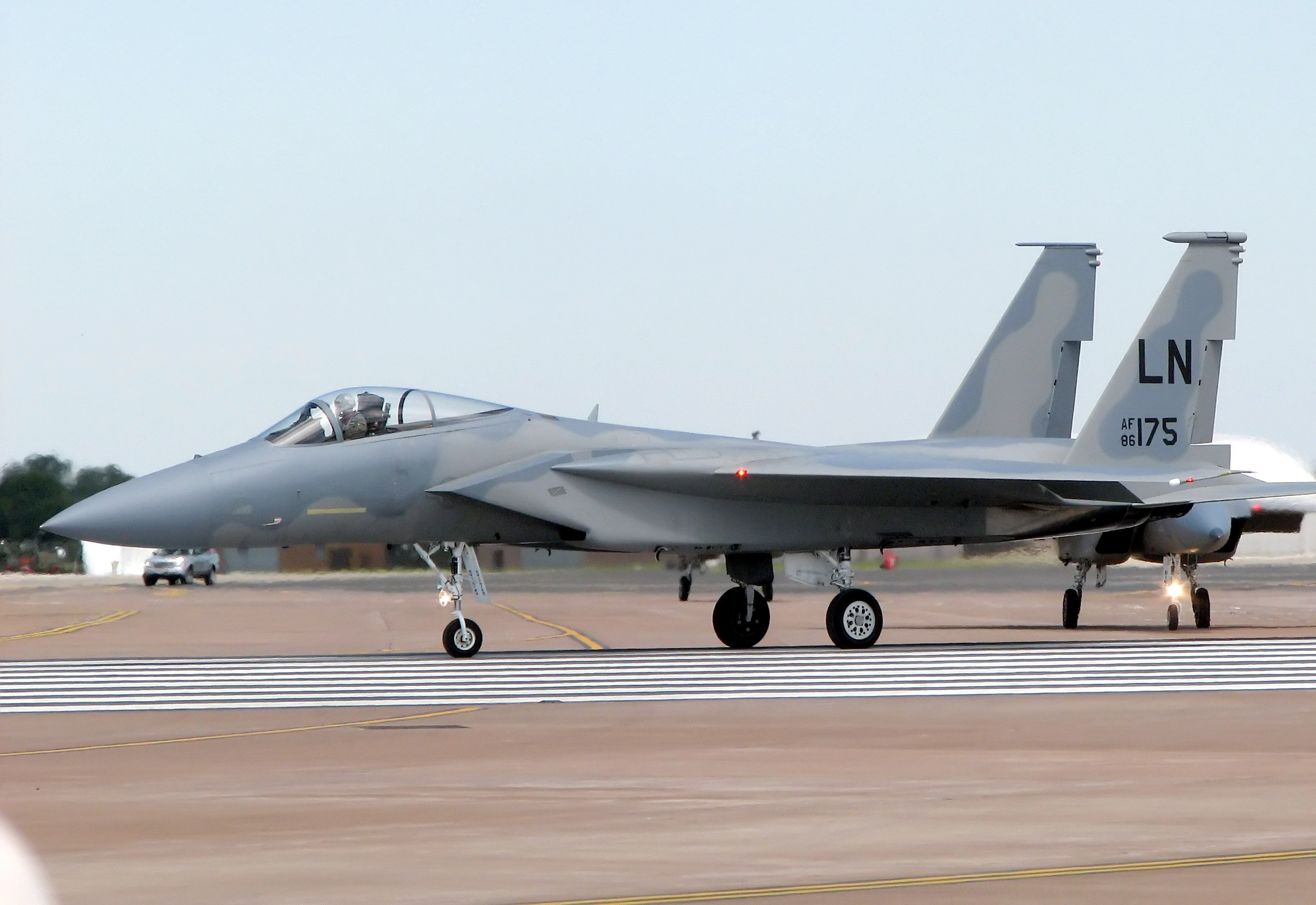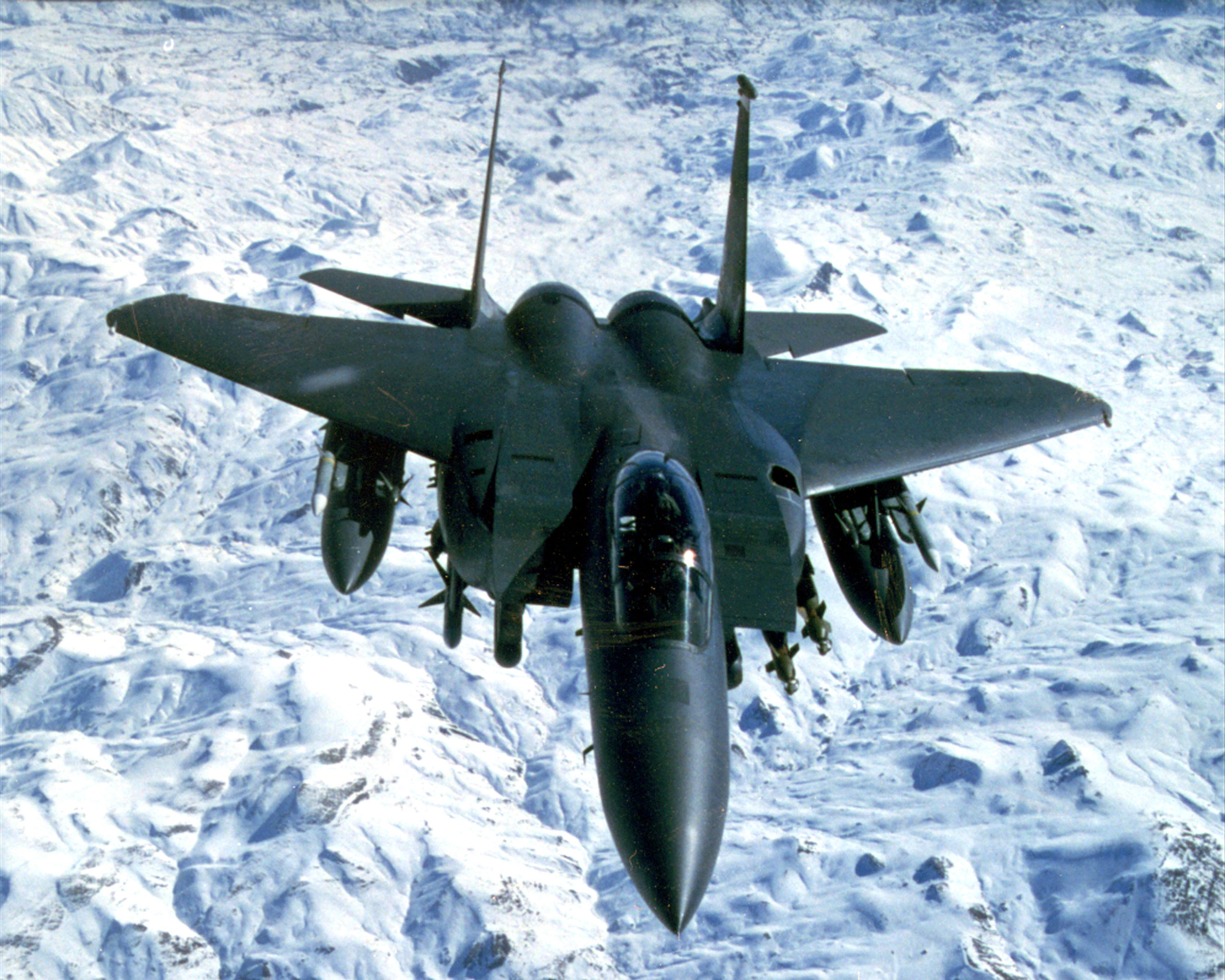 A United States Air Force F-15C Eagle taxiing for takeoff at the Royal International Tattoo, Royal Air Force Fairford, Gloucestershire, England. (Photographed by Adrian Pingstone. July 17th, 2006.)
A United States Air Force F-15C Eagle taxiing for takeoff at the Royal International Tattoo, Royal Air Force Fairford, Gloucestershire, England. (Photographed by Adrian Pingstone. July 17th, 2006.)Origin...
The McDonnel Douglas F-15 Eagle had its origins when the United States found out that the Soviet Union was building an aircraft designated the MiG-25, known to the North Atlantic Treaty Organization as "Foxbat", which was intended to be an high-speed interceptor. However, the MiG-25's huge tailplanes, and vertical stabilizers (tail fins) made it seem like it was very maneuverable, and therefore must be an air superiority fighter. It worried the United States Air Force that this aircraft might perform better than any of the aircraft they have at the moment. However, this was not the case, the tailplanes, and vertical stabilizers (tail fins) of the MiG-25 was to prevent inertia coupling, that would happen in high speed, and altitude flight. The McDonnel Aircraft F-4 Phantom II was the only plane that had enough range, power, and maneuverability to deal with Soviet Fighters, but they could not engage targets at long ranges. As a result, the United States Air Force created the 'F-X' Program to build a new fighter that would overcome the setbacks of the F-4 Phantom, and the McDonnel Douglas F-15 Eagle was developed.
Design...
The F-15 has fantastic maneuverability, which it owes to its high thrust-to-weight ratio, and low wing loading (weight-to-wing area ratio). These enable the Eagle to turn without losing airspeed. It can climb up to 9 000 m (30 000 ft.) in about 60 seconds. The F-15 has two Pratt & Whitney F100 Engines, which is so powerful, that the thrust output of both of them exceeds the weight of the Eagle, which allows it to accelerate in a Vertical Climb.
The F-15 Eagle's multi-mission avionics systems feature a Heads-Up Display (H.U.D.), Inertial Guidance System (I.N.S.), advanced radar, Ultra High Frequency (U.H.F.) communications, flight instruments, and Tactical Air Navigation (T.A.C.A.N.), and Instrument Landing System (ILS) recievers. In addition, the Eagle has a internally mounted, tactical electronic-warfare system, electronic countermeasures suite, "identification friend or foe" system, and a central digital computer.
The heads-up display, visible in any light condition, of the F-15 allows the pilot to gather information quickly to track, and destroy hostile aircraft, without looking down at the cockpit instruments.
The APG-63/70 Pulse-Doppler, a versatile radar that the F-15 uses, can look at both high-flying, and low-flying targets, without being confused by the ground cluttering. It can detect small high-speed targets beyond visual range (the maximum is 120 nautical miles, or 222 km or, 138.75 miles away.), close-up, or treetop altitude. The radar also feeds information into the central computer that will enable effective weapons delivery, with the capability to lock on to targets about 50 nautical miles (91 km, or 56.865 miles) away from the Eagle with an AIM-120 AMRAAM (pronounced as am-ram). If, in a dogfight, the radar would automatically acquire the enemy aircraft(s), and projects the information on the Heads-Up Display, while the Electronic Warfare System provides both automatic countermeasures against selected threats, and threat warning.
F-15E Strike Eagle...
 A United States Air Force F-15E flying over Northern Iraq's snow covered mountains, doing a routine patrol of the skies in support of Operation Northen Watch. This Strike Eagle is from the 494th Expeditionary Fighter Squadron, Royal Air Force, Lakenheath, United Kingdom. (Photographed by Captain Patricia Lang, United States Air Force. February 18th, 1999.)
A United States Air Force F-15E flying over Northern Iraq's snow covered mountains, doing a routine patrol of the skies in support of Operation Northen Watch. This Strike Eagle is from the 494th Expeditionary Fighter Squadron, Royal Air Force, Lakenheath, United Kingdom. (Photographed by Captain Patricia Lang, United States Air Force. February 18th, 1999.)McDonnel Douglas designed the F-15 with "not pound for air-to-ground", and that is exactly what they did. The F-15 was a pure Fighter. But its potential for the Attack role became more, and more apparent as time passed, and it was realized in 1987 in the form of the F-15E Strike Eagle. The Strike Eagle is a two-seat, dual-role, strike aircraft that replaced the General Dynamics F-111 Aardvark , and it can reach speeds up to Mach 2.5. It is a totally integrated fighter for all-weather, deep interdiction, and air-to-air missions. It is armed with L.A.N.T.I.R.N. pods, and a high-resolution APG-70 radar to provide thermal imagery for low-altitude, precision attack, and high-speed penetration on tactical targets in adverse weather, and at night. The rear cockpit is also upgraded with four multi-purpose C.R.T. displays for weapons managements, and aircraft systems. Finally, for coupled automatic terrain following, the McDonnel Douglas F-15E Strike Eagle has a triple redundant, digital Lear Siegler flight control system, which is enhanced by a ring-laser gyro inertial navigation system.
Armament...
The F-15, being a fighter, has the capability of using three different types of missiles, the AIM-9 Sidewinder, the AIM-7F Sparrow, and the AIM-120 AMRAAM. It operates with a conventional jet cannon, the M61A1 Gatling Gun, which is internally mounted, and uses a 20 mm round, with 940 rounds.
 An F-15C of the United States Air Force, piloted by First Lieutenant Charles Schuck, fires an AIM-7 Sparrow over the Gulf of Mexico, supporting a Combat Archer air-to-air weapons system evaluation program mission. He is among the Airmen of the 71st Fighter Squadron deployed from Langley Air Force Base to support this mission. (Photographed by United States Air Force Master Sergeant Micheal Ammons. 2005. No exact date available, I apologize for any inconvenience.)
An F-15C of the United States Air Force, piloted by First Lieutenant Charles Schuck, fires an AIM-7 Sparrow over the Gulf of Mexico, supporting a Combat Archer air-to-air weapons system evaluation program mission. He is among the Airmen of the 71st Fighter Squadron deployed from Langley Air Force Base to support this mission. (Photographed by United States Air Force Master Sergeant Micheal Ammons. 2005. No exact date available, I apologize for any inconvenience.)The McDonnel Douglas F-15 Eagle, and F-15E Strike Eagle participated in... (till 2008.)
- Moshe Melnik of the Israeli Air Force made the first kill in an F-15 in the 1979, shooting down a MiG-21 "Fishbed".
- the shooting down of 13 Syrian MiG-21 "Fishbed"s, and two MiG-25 "Foxbat"s, by Israeli pilots in the 1979-1981 Israeli-Lebanese border disputes.
- the Bekaa Valley Operation.
- the 1982 Lebanon War.
- the shooting down of two F-4E Phantom IIs of the Iranian Air Force in June, 1984, during a border skirmish.
- the Gulf War, and its various Operations.
- Operation Southern Watch, and Operation Southern Watch.
- Operation Provide Comfort.
- Operation Denied Flight
- Operation Allied Force.
- Operation Enduring Freedom.
- Operation Iraqi Freedom.
- North Atlantic Treaty Organization operations in Bosnia.
- recent air expeditionary force deployments.
- the accidental shooting down of two United States Air Force UH-60 Blackhawks in the Northern No-Fly Zone of Iraq. The F-15C pilots thought they were Iraq Hinds.
Operators... (F-15 only in Italic. F-15E only in Bold. Both in Bold Italic.)
- United States of America.
- Japan.
- Israel.
- Saudi Arabia.
- Singapore.
- South Korea.
Specifications. Wikipedia.
General Characteristics...
- Crew: 1.
- Length: 63 ft 9 in (19.43 m).
- Wingspan: 42 ft 10 in (13.05 m).
- Height: 18 ft 6 in (5.63 m).
- Wing area: 608 ft² (56.5 m²).
- Airfoil: NACA 64A006.6 root, NACA 64A203 tip.
- Empty weight: 28,000 lb (12,700 kg).
- Loaded weight: 44,500 lb (20,200 kg).
- Max takeoff weight: 68,000 lb (30,845 kg).
- Powerplant: 2× Pratt & Whitney F100-100,-220 or -229 afterburning turbofans.
- Dry thrust: 17,450 lbf (77.62 kN) each.
- Thrust with afterburner: 25,000 lbf for -220; 29,000 lbf for -229 (111.2 kN for -220; 129.0 kN for -229) each.
Performance...
- Maximum speed:
- High altitude: Mach 2.5+ (1,650 mph, 2,660 km/h).
- Low altitude: Mach 1.2 (900 mph, 1,450 km/h).
- Combat radius: 1,061 nmi (1,222 mi, 1,967 km) for interdiction mission.
- Ferry range: 3,100 nmi (3,570 nmi, 5,745 km) with external conformal fuel tanks.
- Service ceiling: 65,000 ft (20,000 m).
- Rate of climb: >50,000 ft/min (254 m/s).
- Wing loading: 73.1 lb/ft² (358 kg/m²).
- Thrust/weight: 1.12 (-220), 1.30 (-229).
- Guns: 1× internally mounted 20 mm (0.787 in) M61A1 gatling gun, 940 rounds.
- Hardpoints: four wing, four fuselage, two wing stations, centerline station, optional fuselage. pylons with a capacity of 16,000 lb (7,300 kg).
- Missiles:
- AIM-7F Sparrow.
- AIM-120 AMRAAM.
- AIM-9 Sidewinders.
Avionics...
- Radar:
- Raytheon AN/APG-63, or AN/APG-70, or
- (Although several F-15C aircraft were produced with APG-70 radar, all have been retrofitted to the AN/APG-63(V)1 configuration)
- Raytheon AN/APG-63(V)1, or
- Raytheon AN/APG-63(V)2 Active Electronically Scanned Array (A.E.S.A.), or
- Raytheon AN/APG-63(V)3 Active Electronically Scanned Array (A.E.S.A.).
- Both active AF and ANG F-15Cs will receive another (up to) 48 V3 units between 2009-2015, over the existing 19 aircraft.
- Countermeasures:
- AN/APX-76 or AN/APX-119 Identify Friend/Foe (I.F.F.) interrogator.
- Magnavox AN/ALQ-128 Electronic Warfare Warning Set (E.W.W.S.) -part of Tactical Electronic Warfare Systems (T.E.W.S.).
- Loral AN/ALR-56 Radar Warning Receiver (R.W.R.)-part of Tactical Electronic Warfare Systems (T.E.W.S.).
- Northrop ALQ-135 Internal Countermeasures System (I.C.S.) - part of Tactical Electronic Warfare Systems (T.E.W.S.).
- AN/ALE-45 chaff/flare dispensers.
- Others:
- Joint Helmet Mounted Cueing System.
Other facts...
- F-15 Eagles has a combined kill record of 104 kills-0 loses in air combat. (all air forces.)
- Over half of the F-15 Eagle's kills were made by pilots of the Israeli Air Force.
- The F-15 is a satellite-killer, using the ASM-135 Anti-Satellite (A.S.A.T.) missile.
- All F-15 aircraft of the United States Air Force were grounded when a Missouri Air National Guard F-15C came apart mysteriously in flight, and crashed on November 2nd, 2007. The F-15Es were cleared for continued operations. On January 8th, 2008, the United States Air Force Air Combat Command cleared a portion of its F-15 A-D models fleet for return to flight status. The rest of the F-15 models (A-D) were cleared on February 15th, 2008 for Engineering Reviews, Flight Pending Inspections, and any required repairs. It was suspected that a critical location in the Upper Longerons caused the failure, resulting to the tear away of the fuselage forward of the air intakes, including the cockpit, and radome, to seperate from the airframe. A report that was released on January 10th, 2008, indicated that nine other F-15s had the problem too. As a result, the F-15's "long-term future is in the question." as stated by General John D. W. Corley. The grounding forced some states to rely on Canada's jet fighters for air defense protection. Alaska had to depend on the Canadian Forces' support.
*To view some awesome pictures of the F-15 Eagle, please click here.


No comments:
Post a Comment